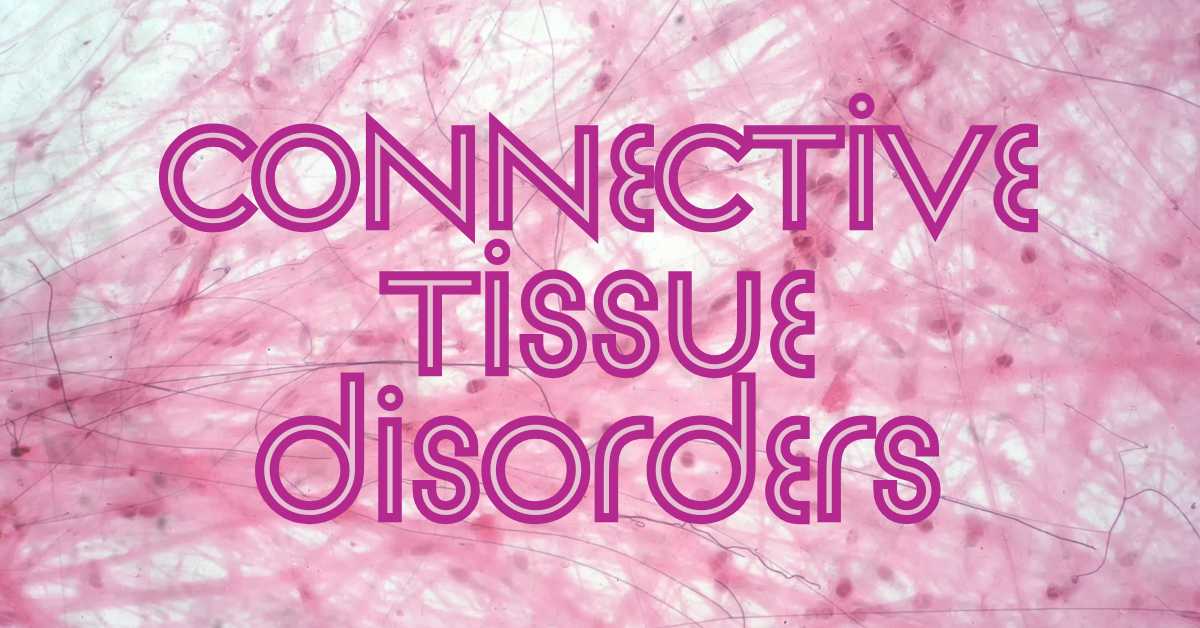Explore how nutrition and lifestyle interventions can support individuals managing challenging connective tissue disorders.
Connective tissue disorders like Mast Cell Activation Syndrome (MCAS), Postural Orthostatic Tachycardia Syndrome (POTS), and Hypermobile Ehlers-Danlos Syndrome (hEDS) often co-occur, forming what’s colloquially known as the “trifecta.”
I have to admit that, all through my undergraduate and graduate health science courses, I don’t remember coming across any of these named disorders and am only now starting to work with patients who have been diagnosed with them, so, of course, I thought I would learn as much as I could and share what I find with you, dear readers. These conditions can significantly impact daily life, and, like most health concerns, it turns out that targeted nutrition and lifestyle strategies offer avenues for symptom management and improved quality of life.
Overview
Let’s first start with the basics: what even is connective tissue? Connective tissue is one of the body’s essential building blocks. As the name suggests, it helps connect and support different structures in the body—playing a role in everything from holding our organs in place to giving strength to our joints, skin, and bones. While connective tissues can look and act quite differently depending on where they’re located, they all share similar structural roles and materials, like collagen, elastin, and specialized cells. [1].
When connective tissue doesn’t form or function properly—often due to genetic mutations or immune system malfunctions—it can affect many different systems in the body. Some well-known genetic connective tissue disorders include:
- Hypermobile Ehlers-Danlos Syndrome (hEDS) – often involves hypermobile joints, stretchy skin, and chronic pain
- Marfan Syndrome – typically seen in taller individuals with long limbs and cardiovascular concerns
- Osteogenesis Imperfecta (aka Brittle Bone Disease) – a condition that leads to fragile, easily broken bones
- Epidermolysis Bullosa – a rare disorder causing extremely delicate, blister-prone skin
There are also autoimmune connective tissue diseases, such as:
- Systemic lupus erythematosus (SLE) – can cause inflammation and pain in any part of the body
- Rheumatoid arthritis – commonly affects the joints of the hands, knees or ankles
- Scleroderma – involves the hardening and tightening of the skin
- Sjögren’s syndrome – mainly causes dry eyes and dry mouth
These conditions occur when the immune system mistakenly attacks the body’s own connective tissues, leading to inflammation and potential damage in joints, skin, muscles, or organs. Some people may have overlapping symptoms of multiple disorders (known as overlap syndrome), or symptoms that don’t clearly match any one disease.
Because connective tissue is found throughout the body, these conditions can impact multiple organs and greatly affect a person’s quality of life. That’s why early recognition, appropriate medical care, and supportive strategies—like personalized nutrition and lifestyle changes—can make a meaningful difference.
Mast Cell Activation Syndrome (MCAS)
Mast Cell Activation Syndrome (MCAS) involves the inappropriate activation of mast cells, leading to a range of symptoms including hives, gastrointestinal distress, and anaphylaxis. Mast cells are a type of immune cell that play a big role in how the body responds to injury, allergens, and threats like bacteria or toxins. You can think of them as first responders—stationed throughout the body, especially in the skin, lungs, digestive tract, and connective tissue. When activated, they release chemical messengers like histamine and tryptase, which help spark inflammation, recruit other immune cells, and protect the body. (Fun fact: in my undergrad A&P class, I would make up interpretive dances to help me memorize the functions of mast cells. Sadly, nobody ever thought to take a video of them, but I SWEAR THEY HAPPENED.)
In some people, mast cells become overactive or unstable; i.e., reacting to things that shouldn’t be harmful. This can lead to a condition called Mast Cell Activation Syndrome (MCAS), where repeated, unpredictable “flare-ups” of symptoms like hives, flushing, fatigue, digestive issues, or rapid heart rate can significantly impact daily life [2].
While no universal diet exists, many find relief with low-histamine, gluten-free, or low-amine diets. And, while it can seem time intensive, an elimination-reintroduction diet can help identify personal triggers [3]. Contrary to popular belief, there is no official “anti-inflammatory” diet, but there are anti-inflammatory foods that may stabilize mast cells. These include the usual suspects: dark and richly colored fruits and vegetables like onions, blueberries, and asparagus, and omega-3-rich foods like salmon, walnuts, and fortified foods.
- Specialist Highlight: Joshua Morgan, APD, specializes in MCAS nutrition management.
Postural Orthostatic Tachycardia Syndrome (POTS)
Postural Orthostatic Tachycardia Syndrome (POTS) is characterized by an excessive heart rate increase upon standing, leading to dizziness, fatigue, and palpitations. While not a direct disorder itself, many people who do have connective tissue disorders may also experience POTS due to underlying autonomic dysfunction exacerbated by the connective tissue abnormalities.
In the case of POTS, some people have found that increasing salt and fluid intake can help expand blood volume, alleviating symptoms [4]. Foods rich in potassium and electrolytes, like bananas and bone broth, can support cardiovascular stability. Other common nutrition interventions include consuming smaller, more frequent meals may prevent blood pooling in the gastrointestinal tract [5].
- Specialist Highlight: Bonnie Nasar, RDN, of Nasar Nutrition offers services focusing on POTS dietary management.
Hypermobile Ehlers-Danlos Syndrome (hEDS)
Hypermobile Ehlers-Danlos Syndrome (hEDS) is a connective tissue disorder that affects the body’s collagen, a key protein that provides strength and flexibility to joints, skin, and other tissues. People with hEDS often have very flexible (or “hypermobile”) joints, which can lead to frequent dislocations, sprains, chronic pain, and fatigue. Their skin may be soft or stretchy, and wound healing can sometimes be slower than usual, which makes sense since their connective tissues are unable to connect properly. Because connective tissue is found throughout the body, hEDS can also affect digestion, bladder function, blood pressure, and more. While symptoms and severity can vary widely, hEDS is often underdiagnosed or misunderstood—making education, proper medical care, and supportive therapies like nutrition, physical therapy, and pacing strategies especially important.
Similar to above approaches, an anti-inflammatory diet may reduce systemic inflammation and support joint health [6]. But because hEDS may have related gut issues, addressing gastrointestinal issues like chronic stomach pain (dyspepsia) and reflux is crucial. If you’ve learned anything from my past gut health webinars, you know that Supplementing with nutrients like vitamin D, B12, and iron can combat deficiencies.
- Specialist Highlight: Savvy Dietetics, an Australia-based healthcare group, provides tailored nutrition plans for individuals with hEDS.
The Interconnectedness of MCAS, POTS, and hEDS
As mentioned above, these conditions often overlap, with shared symptoms and triggers, necessitating a comprehensive management approach [7]. Collaborative care involving dietitians, physicians, and therapists ensures holistic treatment. And, as always, personalized nutrition plans addressing all three conditions can lead to better outcomes since each person may suffer and experience their diagnosis in different ways.
For an inside scoop on Hypermobile Ehlers-Danlos Syndrome (hEDS), check out our conversation with Registered Dietitian Cheryl Iny Harris.
Empowering Through Knowledge and Support
Managing MCAS, POTS, and hEDS requires a nuanced understanding of each condition and their interplay. Through informed nutrition and lifestyle choices, individuals can take proactive steps toward improved well-being [8]. Connecting with specialized healthcare professionals further enhances the journey toward health. As with the most complex symptoms or rarest conditions, there is usually an organization dedicated to providing help to those who need it. If you or someone you know suffers from a connective tissue disorder, consider reaching out to the following:
References
- Kamrani, P., Jan, A., Marston, G., & Arbor, T. C. (2023, March 5). Anatomy, Connective Tissue. National Library of Medicine; StatPearls Publishing. https://www.ncbi.nlm.nih.gov/books/NBK538534/
- Komi, D. E. A., Khomtchouk, K., & Santa Maria, P. L. (2019). A Review of the Contribution of Mast Cells in Wound Healing: Involved Molecular and Cellular Mechanisms. Clinical Reviews in Allergy & Immunology, 58(3), 298–312. https://doi.org/10.1007/s12016-019-08729-w
- Nutrition – TMS – The Mast Cell Disease Society, Inc. (2022, September 21). TMS – the Mast Cell Disease Society, Inc. https://tmsforacure.org/nutrition/
- Nutrition Stategies for Managing POTS | Standing Up To POTS. (n.d.). Www.standinguptopots.org. https://www.standinguptopots.org/nutritionstrategiesPOTS
- Diet and Fluids. (n.d.). PoTS UK. https://www.potsuk.org/managingpots/diet-and-fluids-2/
- Garvey, K. (n.d.). Nutrition and Ehlers-Danlos Syndrome. Tulane Hypermobility and Ehlers-Danlos Clinic. https://hypermobilityclinic.org/nutrition-and-ehlers-danlos-syndrome/
- Sherrell, Z. (2024, August 12). Ehlers-Danlos syndrome and POTS: What is the link? Medicalnewstoday.com; Medical News Today. https://www.medicalnewstoday.com/articles/ehlers-danlos-syndrome-and-pots
- Nutrient Considerations in EDS, MCAS, POTS, and other Neuroimmune Conditions | The EDS Clinic. (2024). Eds.clinic. https://www.eds.clinic/articles/nutrient-considerations-in-eds-mcas-pots-and-other-neuroimmune-conditions



0 Comments